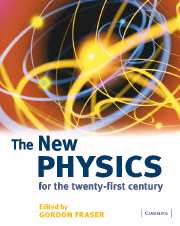Book contents
- Frontmatter
- Contents
- Contributors
- Editor’s acknowledgements
- Introduction: The new physics for the Twenty-First Century
- I Matter and the Universe
- 1 Cosmology
- 2 Gravity
- 3 The new astronomy
- 4 Particles and the Standard Model
- 5 Superstring theory
- II Quantum matter
- III Quanta in action
- IV Calculation and computation
- V Science in action
- Index
- References
2 - Gravity
Published online by Cambridge University Press: 05 June 2014
- Frontmatter
- Contents
- Contributors
- Editor’s acknowledgements
- Introduction: The new physics for the Twenty-First Century
- I Matter and the Universe
- 1 Cosmology
- 2 Gravity
- 3 The new astronomy
- 4 Particles and the Standard Model
- 5 Superstring theory
- II Quantum matter
- III Quanta in action
- IV Calculation and computation
- V Science in action
- Index
- References
Summary
The attraction of gravity
Gravity attracts. It attracts every body in the Universe to every other, and it has attracted the interest of physicists for centuries. It was the first fundamental force to be understood mathematically in Isaac Newton’s action-at-a-distance theory, it is a center of current attention in Albert Einstein’s general relativity theory, and it promises to be the last force to be fully understood and integrated with the rest of physics.
After centuries of success, Newton’s theory was finally replaced by Einstein’s theory, which describes gravity at a deeper level as due to curvature of spacetime. General relativity is widely considered to be the most elegant physical theory and one of the most profound. It has allowed the study and understanding of gravitational phenomena ranging from laboratory scale to the cosmological scale – the entire Universe; but many mysteries remain, especially in cosmology.
An impressive understanding of the other fundamental forces of nature, electromagnetism and the weak and strong nuclear forces, is now embodied in the Standard Model of elementary particles. However, these other forces are understood in terms of quantum field theory and are not geometric in the manner of general relativity, so gravity remains apart. Many physicists believe that the final phase of understanding gravity will be to include quantum effects and form a union of general relativity and the Standard Model. We would then understand all the forces and spacetime on a fundamental quantum level. This is proving to be quite a task.
- Type
- Chapter
- Information
- The New PhysicsFor the Twenty-First Century, pp. 41 - 68Publisher: Cambridge University PressPrint publication year: 2006

